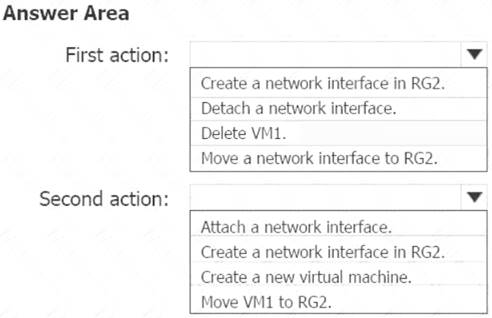- (Exam Topic 5)
You have an app named App1 that runs on two Azure virtual machines named VM1 and VM2.
You plan to implement an Azure Availability Set for App1. The solution must ensure that App1 is available during planned maintenance of the hardware hosting VM1 and VM2.
What should you include in the Availability Set?
Correct Answer:D
Microsoft updates, which Microsoft refers to as planned maintenance events, sometimes require that VMs be rebooted to complete the update. To reduce the impact on VMs, the Azure fabric is divided into update domains to ensure that not all VMs are rebooted at the same time.
- (Exam Topic 6)
You have an existing Azure subscription that contains 10 virtual machines.
You need to monitor the latency between your on-premises network and the virtual machines. What should you use?
Correct Answer:C
Network Performance Monitor is a cloud-based hybrid network monitoring solution that helps you monitor network performance between various points in your network infrastructure. It also helps you monitor network connectivity to service and application endpoints and monitor the performance of Azure ExpressRoute.
You can monitor network connectivity across cloud deployments and on-premises locations, multiple data centers, and branch offices and mission-critical multitier applications or microservices. With Performance Monitor, you can detect network issues before users complain.
Reference:
https://docs.microsoft.com/en-us/azure/azure-monitor/insights/network-performance-monitor
- (Exam Topic 6)
You have an Azure web app named App1 that has two deployment slots named Production and Staging. Each slot has the unique settings shown in the following table.
You perform a slot swap.
What are the configurations of the Production slot after the swap? To answer, select the appropriate options in the answer area.
NOTE: Each correction is worth one point.
Solution:
Which settings are swapped?
When you clone configuration from another deployment slot, the cloned configuration is editable. Some configuration elements follow the content across a swap (not slot specific), whereas other configuration elements stay in the same slot after a swap (slot specific). The following lists show the settings that change when you swap slots.
Box 1 : On
Settings that are swapped:
General settings, such as framework version, 32/64-bit, web sockets
App settings (can be configured to stick to a slot) Connection strings (can be configured to stick to a slot) Handler mappings
Public certificates WebJobs content Hybrid connections *
Virtual network integration * Service endpoints *
Azure Content Delivery Network *
Features marked with an asterisk (*) are planned to be unswapped.
So web sockets settings will be swapped. So Production will have web sockets settings from "Off" to " On" after the swap slot.
Box 2: App1-prod.contoso.com Settings that aren't swapped: Publishing endpoints
Custom domain names
Non-public certificates and TLS/SSL settings Scale settings
WebJobs schedulers IP restrictions Always On Diagnostic settings
Cross-origin resource sharing (CORS)
So Custom domain names will not be swapped. So Production will have Custom domain names of its own after the swap slot.
Reference:
https://docs.microsoft.com/en-us/azure/app-service/deploy-staging-slots#what-happens-during-a-swap
Does this meet the goal?
Correct Answer:A
- (Exam Topic 6)
Your company registers a domain name of contoso.com.
You create an Azure DNS named contoso.com and then you add an A record to the zone for a host named www that has an IP address of 131.107.1.10.
You discover that Internet hosts are unable to resolve www.contoso.com to the 131.107.1.10 IP address. You need to resolve the name resolution issue.
Solution: You modify the name server at the domain registrar. Does this meet the goal?
Correct Answer:B
References:
https://docs.microsoft.com/en-us/azure/dns/dns-delegate-domain-azure-dns
- (Exam Topic 6)
You have an Azure subscription named Subscription1. Subscription1 contains the resources in the following table.
VNet1 is in RG1. VNet2 is in RG2. There is no connectivity between VNet1 and Vnet2.
An administrator named Admin1 creates an Azure virtual machine named VM1 in RG1. VM1 uses a disk named Disk1 and connects to VNet1. Admin1 then installs a custom application in VM1.
You need to move the custom application to Vnet2. The solution must minimize administrative effort. Which two actions should you perform? To answer, select the appropriate options in the answer area. NOTE: Each correct selection is worth one point.
Solution:
We cannot just move a virtual machine between networks. What we need to do is identify the disk used by the VM, delete the VM itself while retaining the disk, and recreate the VM in the target virtual network and then attach the original disk to it.
First action: Delete VM1
Second action: Create a new virtual machine Reference:
https://docs.microsoft.com/en-us/archive/blogs/canitpro/step-by-step-move-a-vm-to-a-different-vnet-on-azure
https://4sysops.com/archives/move-an-azure-vm-to-another-virtual-network-vnet/#migrate-an-azure-vmbetween
Does this meet the goal?
Correct Answer:A